The U.S. Army and the Republic of Korea (ROK) military conducted a precision-strike exercise in response to North Korea’s purported first-ever flight test of an intercontinental ballistic missile on July 4, United States Forces Korea (USFK) said in a statement.
“This exercise utilized the Army Tactical Missile System (ATACMS) and the Republic of Korea Hyunmoo Missile II, which fired missiles into territorial waters of South Korea along the East Coast,” according to USFK. “The system can be rapidly deployed and engaged. The deep strike precision capability enables the ROK-U.S. Alliance to engage the full array of time critical targets under all weather conditions.”
The ROK military currently operates two variants of the Hyunmoo missile, the Hyunmoo 2A and 2B ballistic missiles. Both are surface-to-surface missiles with an estimated maximum range of 300 kilometers and 500 kilometers respectively, each capable of carrying a payload of up to 997 kilograms.
As I reported previously, South Korea is also working on fielding an extended range Hyunmoo 2 missile with an estimated range of 800 kilometers. The last test launch of this new missile, likely to be designated the Hyunmoo 2c, took place on June 23 and was overseen by South Korean President Moon Jae-in. The new missile is expected to become operational by the end of 2017.
The new Hyunmoo missile will “be a key component in our kill chain to counter possible North Korean missile attacks,” according to a ROK government spokesperson on June 23. It will be an integral part of South Korea’s deterrence strategy, known as Korea Massive Punishment & Retaliation (KMPR). As I explained elsewhere:
In the event of a North Korean nuclear attack (or even signs of preparations for one), KMPR specifically calls for surgical strikes against key leadership figures of the communist regime and military infrastructure with the missiles part of a so-called kill chain consisting of integrated information, surveillance, and strike systems, as well as the Korea Air and Missile Defense (KAMD) system.
The U.S. and ROK militaries have deployed near the intra-Korean border dozens of US-made surface-to-surface precision-guided Army Tactical Missile Systems (ATACMS) capable of hitting the North Korean capital Pyongyang. The ATACMS is a surface-to-surface missile with an estimated range of around 300 kilometers.
On July 5, South Korea’s military also released a video showing a ROK Air Force F-15K Slam Eagle fighter jet firing a Taurus KEPD 350 long-range precision-guided cruise missile successfully destroying its target, according to Yonhap news agency. South Korea received its first lot of air-launched Taurus cruise missiles, with a range of over 500 kilometers, in October 2016. The ROK military’s Taurus arsenal is estimated at 170-180 missiles.

































